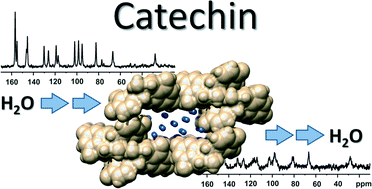Computational and experimental study of reversible hydration/dehydration processes in molecular crystals of natural products – a case of catechin†
Abstract
When employing a complementary approach that joins theoretical (crystal structure prediction, CSP, gauge-including projector-augmented wave density functional theory, GIPAW DFT) and experimental (solid-state nuclear magnetic resonance, SSNMR) techniques, we prove that detectable changes in the water content in a crystal lattice can be monitored as a continuous or quantum process by using border values of the measurable number of water molecules in the crystal, depending on the observation probe. In the case of a 13C nucleus, which “feels” the presence of water in its nearest neighbourhood, the subtle changes in the structure of the water channel during the dehydration/rehydration process are not reflected until the water loss exceeds a certain number of molecules. Here, the dehydration of (+)-catechin 4.5-hydrate with a loss of ca. 1–1.5 and 2–2.5H2O molecules leads to microcrystalline form II (partially dehydrated) or amorphous form III, respectively. The CSP calculations for the partially dehydrated (+)-catechin (form II), as verified by experimental 1H and 13C shieldings, resulted in two similar probable crystal structures, which have 2 and 2.5 water molecules in the unit cell.


 Please wait while we load your content...
Please wait while we load your content...